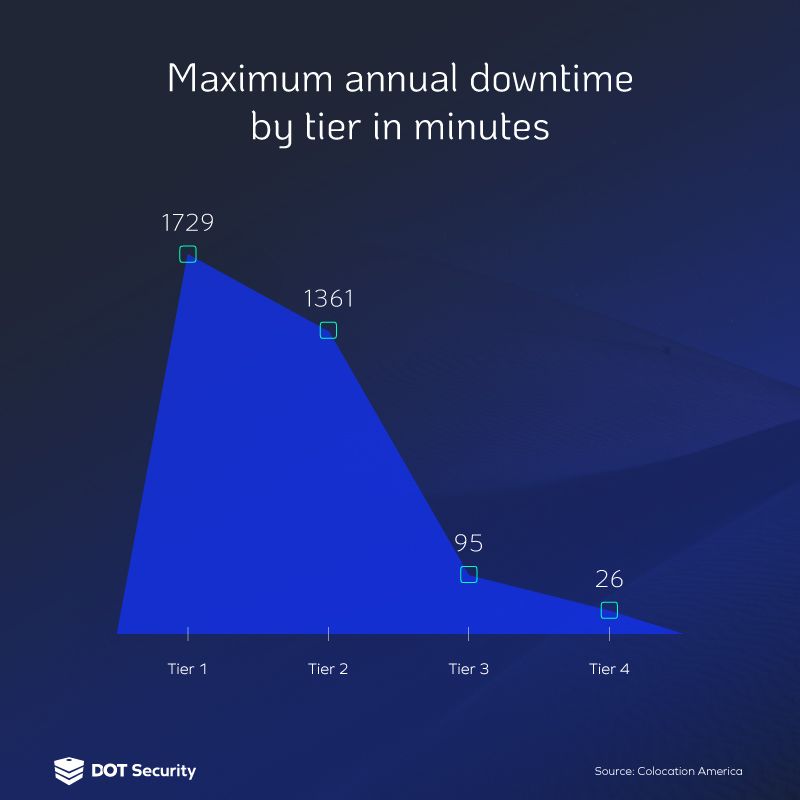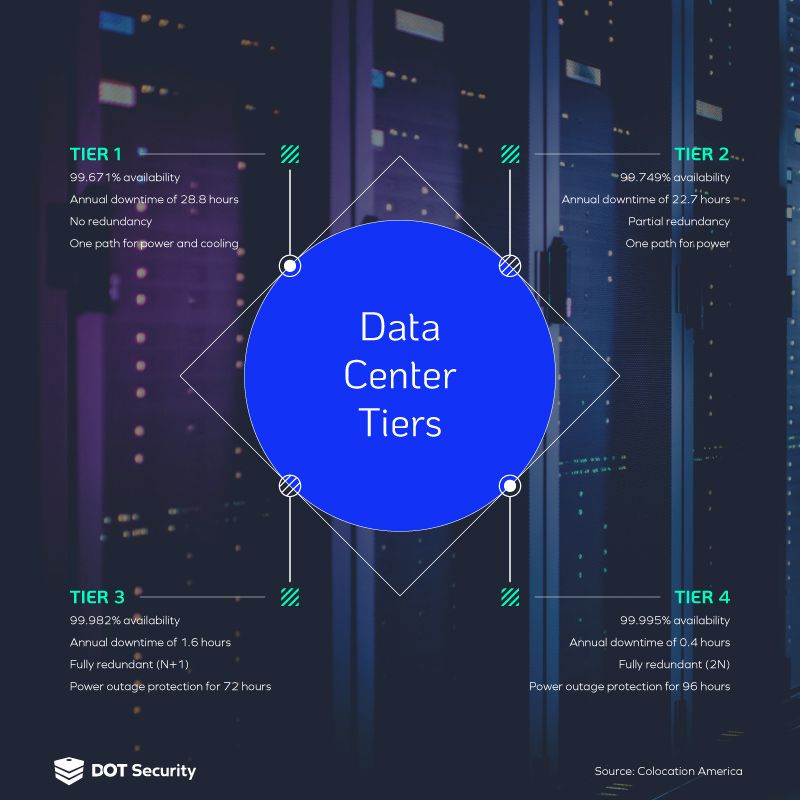Secure Data Protection
What Are Data Center Tiers and How Do They Affect Your Business?
March 09, 2023
6 minutes

Prolonged or frequent periods of downtime can have a devastating cost for businesses which means ensuring business continuity has become a major concern for executives and decision-makers in many different industries.
Securing your cloud-stored data is an important step toward being more secure, but it is just one step. Download the checklist, How Covered is Your Business?, to see what else your business needs to be as protected as possible against cyber threats.
Explaining Data Center Tiers
Prolonged or frequent periods of downtime can have a devastating cost for businesses which means ensuring business continuity has become a major concern for executives and decision-makers in many different industries.
With SMBs being targeted more frequently in cyberattacks, deciding where you store your data has become a crucial decision that could have a substantial impact, especially as businesses migrate more information onto the cloud.
Related Blog: 8 Database Security Best Practices to Know
Data center tiers are ratings that measure the performance of the servers that house the data and information stored at the data center.
Each tier represents the level of security and the levels of potential downtime you could experience over the course of a year due to unexpected outages and disruptions.
Data centers are ranked from I to IV, with I being the worst performing and IV being the best.
Let’s take a closer look at what data center tiers are and how their ratings are determined, what each tier means, and what you need to know about each one.
Sign up for our newsletter !
How is a Data Center Tier Determined?
The standard of data center tiers is managed by the Uptime Institute, an independent organization that administers the certifications.

The Uptime Institute determines the criteria for each tier and maintains the key values which make up the standards of the data center tiers.
Key Factors of the Data Center Tier Ratings
- Performance: The tier standards are performance-based, meaning any design solution that meets the standard requirements for availability, redundancy, and fault tolerance is acceptable. This allows data centers to have the ability to incorporate a variety of infrastructure and system solutions to help improve performance and meet their goals.
- Technology Neutral: Due to the constantly changing landscape of technology in the industry, tier classification doesn’t require any fixed set of technology. This also means that organizations are able to comply with any local regulations, codes, and laws without harming their ability to achieve their deserved tier certification.
- Vendor Agnostic: As with technology, the tier standard is neutral when it comes to different brands and their hardware or software.
Defining the Data Center Tier Ratings
Now that we’ve covered the purpose and thought process behind the data center tier standard, let’s discuss what data center tiers are, define each rating, and see what you can expect from them with uptime, downtime, and redundancies as defined by the Uptime Institute.

Tier 1 Data Center
The lowest-rated tier, a Tier 1 data center reaches only the basic capacity level when it comes to the infrastructure and technology needed to support information technology.
This means that a Tier 1 data center can protect against human error but will not protect against unexpected failure or outages due to the lack of redundant devices and components. These data centers can only offer a guaranteed uptime of 99.671%.
A Tier 1 data center must also shut down completely for preventative maintenance and repairs.
In order to qualify for a Tier 1 qualification, the base-level certification offered by the Uptime Institute, a data center must meet these base-level requirements:
• An uninterruptible power supply (UPS) for power sags, outages, and spikes • An area for IT systems • Dedicated cooling equipment that runs outside office hours • An engine generator for power outages
Tier 2 Data Center
A Tier 2 data center maintains all the capabilities and requirements provided by a Tier 1 but with additional redundancy capacity for power and cooling which provide more protection against unexpected disruptions.
Components such as engine generators, energy storage, cooling units, and more give a Tier 2 data center the edge over a Tier 1.
A Tier 2 data center can give you a 99.741% uptime, a 0.07% improvement over a Tier 1 facility which results in about 368 fewer minutes of downtime per year.
Tier 3 Data Center
Tier 3 data centers include additional redundancy components that provide even more protection against outages and disruptions.
With a 99.982% uptime, these added safeguards help give Tier 3 facilities a sizable uptime advantage over Tier 2 and Tier 1 data centers and this is the reason most small and midsize businesses choose Tier 3 as a starting point when choosing a data center.
One of the biggest improvements that Tier 3 data centers have over lower tiers is the required additional redundant paths for backup. This means that a Tier 3 facility does not need to shut down during maintenance, unlike Tiers I and II.
Tier 4 Data Center
Tier 4 data centers are the gold standard for data centers and provide businesses with constant availability and the lowest amount of downtime with an uptime percentage of 99.995% and annual maximum downtime of 26 minutes.
The main difference between Tier 3 and IV data centers is the inclusion of 2N and 2N+1 redundant infrastructure, meaning that Tier 4 facilities have identical replicas for every component ready to make up for failures. These systems are also independent of each other and physically separated to prevent an unplanned disruption from affecting both systems.
Tier 4 facilities also add ‘fault tolerance’ which means that any interruptions, outages, or equipment failures will not affect IT operations due to power backups that can last up to 96 hours.
Tier 4 data centers are also required to have continuous cooling for a more stable environment.
What Data Center Tiers Mean for Cybersecurity
Data centers hold a lot of important and sometimes confidential information, assets, and intellectual property. These are the primary focus of the majority of all targeted attacks against your business’ information.
Related Blog: What is Data Security and Why is it Important?
Many data centers implement levels of security, both physical and digital, to protect the data within. Security measures such as segmentation to limit an attack’s ability to spread, proper visibility to know who is accessing data at all times, and levels of threat protection to help prevent attacks and quickly alert security staff when one occurs.
Which Data Center Tier is Right for Your Business?
Choosing the right data center for your business depends on a variety of factors such as the amount of data you store, your security needs, and your budget.
Using a Tier I or II data center may be the best choice for a smaller business as it is the most budget-friendly option that still provides the basic necessities that you need in data storage. But, you’ll have to consider that you could experience more than 1,000 more minutes of downtime than with a higher-tiered facility.
Tiers III and IV provide a significant increase in uptime per year and provide redundant technology and infrastructure to protect your data from random and unexpected outages. For businesses that need full protection and minimal downtime, Tier IV is recommended, especially if budget constraints aren’t as big of a problem.
Data Centers with an MSP like DOT Security
At DOT Security, we exclusively work with Tier III and Tier IV data centers for our clients. We believe that the security and reliability provided by Tier I and II data centers is not enough for modern businesses that require the best protections against outages and disruptions.
DOT Security specializes in providing a tailored cybersecurity solution that dynamically addresses your businesses’ vulnerabilities to best protect you. With real-time protection and a team of in-house experts at our state-of-the-art Security Operations Center in Illinois, DOT Security is the premier Cybersecurity partner.
Strong cloud storage is important, but only one part of being a secure business. Download the checklist, How Covered is Your Business?, to explore all the cybersecurity tools, strategies, and protocols you need to protect yourself from the huge variety of attack threatening businesses today.
